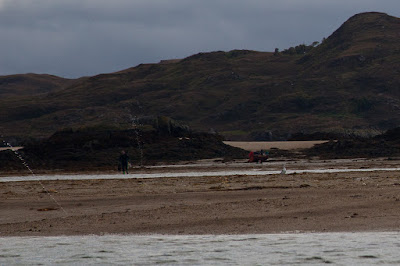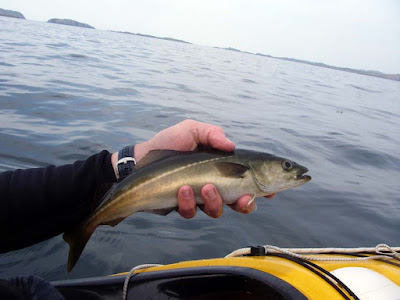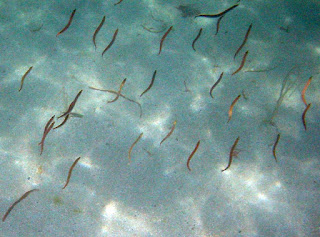We landed on a shell sand beach in the lee of some skerries on the Moidart coastline. We had travelled so far south that Rum now lay behind Eigg on the horizon.
Donald's boat and engines are heavy but high tide was about 8pm and as we intended to launch about 8am the next morning, no hauling up the beach was required. I think I will stick with a sea kayak though!
As the sun set behind the Sgurr of Eigg...
...and as the receding tide left Donald's boat high and dry, we lit a fire on the beach. A bag of barbecue charcoal always makes a good heart for a fire and I had also bought a sack of logs from a petrol station on the road north to Arisaig.
Donald and I reminisced and put the World to rights as our baked potatoes (in tin foil) roasted on the fire...
Imagine you are at the edge of the sea on a day when it is difficult to say where the land ends and the sea begins and where the sea ends and the sky begins. Sea kayaking lets you explore these and your own boundaries and broadens your horizons. Sea kayaking is the new mountaineering.
Wednesday, September 14, 2011
Tuesday, September 13, 2011
A bumpy crossing of the Sound of Arisaig.
From Port nan Murrach, we pointed our bows to the east. We didn't bother exploring Port a' Bhathaich as it is a trap for most of the flotsam and jetsam in the area. Instead, we cut across its mouth and slipped inside Eilean a' Ghaill. It has the remains of a vitrified Iron Age fort on its summit. There is a great view from the top but it is a very steep scramble and although it is only 23m high (and in 2004 I almost skipped up), I knew that as far as I was concerned it could now just as easily have been the Inaccessible Pinnacle on Sgurr Dearg in the Cuillin.
We now had a choice, head up into Loch nam Uamh at the head of the Sound of Arisaig staying in the shelter of the lee of the Arisaig peninsula...
...but it got a little bit bumpy on the crossing especially as we approached the wind over spring tide conditions off Rubha Ghead a' Leighe. Photography stopped until we were well down the Smirisary coast and the water flattened again as in the photo above. Smirisary was a crofting community that survived until the end of the Second World War when it was abandoned. Nowadays, many of the old crofts have been restored as holiday homes.
It was too rough to land on the rocky shore at Smirisary and anyway we still had a way to go before we could finally pull up the boats on another shell sand beach.
We now had a choice, head up into Loch nam Uamh at the head of the Sound of Arisaig staying in the shelter of the lee of the Arisaig peninsula...
Photo by Donald Wilcox
...or head straight across the mouth of the Sound of Arisaig for the distant lands of Moidart. Well it was a no brainer, it was a broad reach on open water all the way to Moidart! At first the sea was nice and flat due to the shelter of Rubh Arisaig......but it got a little bit bumpy on the crossing especially as we approached the wind over spring tide conditions off Rubha Ghead a' Leighe. Photography stopped until we were well down the Smirisary coast and the water flattened again as in the photo above. Smirisary was a crofting community that survived until the end of the Second World War when it was abandoned. Nowadays, many of the old crofts have been restored as holiday homes.
It was too rough to land on the rocky shore at Smirisary and anyway we still had a way to go before we could finally pull up the boats on another shell sand beach.
Monday, September 12, 2011
The plight of the sand bees on the machair at Port nam Murrach.
I was able to nip inside the various reefs in my sea kayak but Donald had to take a wider line.
We had arranged to rendezvous at Port nan Murrach on the Arisaig peninsula.
It wasn't long before Donald joined me in this delightful cove...
Squalls of wind and rain were blasting down from the north but fortunately this one missed us and plastered Eigg instead.
Donald scrambled up the rocks of the surrounding ridges to see what the wind was doing...
...away to the north.
Meanwhile I reaquainted myself with the colony of the rare northern colletes mining bees. These are a solitary species but they make their single burrows in aggregates in the sandy machair. They are a threatened species and there are only a handful of locations on the Scottish mainland where they can still be found.
I was distressed to discover some recent visitors had built a fire right on top of the colony. I hope it was not a group of sea kayakers, most kayakers know to build fires below the high water mark.
While Donald continued to explore the ridges and other beaches in the area, I was content to sit on the rocks with a cup of coffee, admire the view and...
...the marvellous white shell sand. I am so grateful for sea kayaking. I could not have walked to such a wonderful spot.
Sunday, September 11, 2011
sea kayak photo delphin
Even when the sun is not shining, the Arisaig skerries at the mouth of Loch nan Ceall is a remarkable place. The dark rocks and seaweed are...
...interspersed with dazzling shell sand beaches. At low tide the skerries are high above the narrow channels and lagoons but even so...
...the peaks of the Rum Cuillin and...
...the Sgurr of Eigg dominate the scene.
The skerries are also home to large colonies of both common and grey seals. Interestingly Donald's motor boat got right up to them and I could sail very close but as soon as I started to paddle, they would slide into the water...
...and follow me, as seen in this photo from Donald's blog.
...interspersed with dazzling shell sand beaches. At low tide the skerries are high above the narrow channels and lagoons but even so...
...the peaks of the Rum Cuillin and...
...the Sgurr of Eigg dominate the scene.
The skerries are also home to large colonies of both common and grey seals. Interestingly Donald's motor boat got right up to them and I could sail very close but as soon as I started to paddle, they would slide into the water...
...and follow me, as seen in this photo from Donald's blog.
Saturday, September 10, 2011
The ejaculating spoots of Arisaig.
Donald and I first went on an expedition together to the
Skye Cuillin nearly 40 years ago. Sadly the passage of years has not been kind
to my knees and the Cuillin receded on the horizon behind us as we rounded
Eilean Ighe in small boat and kayak. The
sea was still rough after the fresh early morning winds. I cut through the
clapotis by the reefs but Donald in his boat had to take a wider line till we
entered the quiet waters of Arisaig North Channel at low water springs.
Inside the Arisaig skerries we entered a strange new world, which contrasted with the Rum Cuillin mountains on the horizon. The tidal lagoons inside the reefs had nearly emptied, exposing acres of sands that are usually still covered at most low tides.
We were surprised to see many small boats pulled up on the sand banks and the skerries seemed almost thronged with people. Many were carrying buckets and others seemed to be intently studying the sand at their feet.
Then as we drew closer we saw the most amazing sight. Mysterious jets of water were spouting high in the air all over the sands.
Inside the Arisaig skerries we entered a strange new world, which contrasted with the Rum Cuillin mountains on the horizon. The tidal lagoons inside the reefs had nearly emptied, exposing acres of sands that are usually still covered at most low tides.
We were surprised to see many small boats pulled up on the sand banks and the skerries seemed almost thronged with people. Many were carrying buckets and others seemed to be intently studying the sand at their feet.
Then as we drew closer we saw the most amazing sight. Mysterious jets of water were spouting high in the air all over the sands.
The water spouts come from razor clams (spoots in local
parlance), which live deep in the sands. The locals watch for the water jets
then sprinkle salt round the small hole through which they come. A few seconds
later the spoot pops up through the hole and is easily caught. They are
delicious.
Eigg1 has produced an amazing video of catching spoots on the nearby island of Eigg!
Friday, September 09, 2011
Thank goodness for sea kayaking!
In the summer holidays of 2010 my brother Donald joined Phil, Jennifer and I for a paddle round Gigha. At the time I was recovering from my knee operation and had great hopes I might be mountaineering again in 2011. So I said to him "next year we will go to the Cuillins". Sadly my optimism has not been matched by reality. So when he phoned from Arisaig, back in this year's August holidays, I had to decline a mountain trip. Even the little Sgurr of Eigg at 393m was now beyond me. Fortunately sea kayaking is ideal for someone with a lower limb disability, so we decided to go for a boating trip from Portnadoran camp site instead. This photo shows the view from Portnadoran beach to the Skye Cuillin mountains rising into the clouds.
My little kayak on its trolley was easy to get down to the shore. Donald had a much tougher job as the boat and outboards was too heavy and the trailer sunk into the sand. He had to leave the outboards at the road end and then...
...go back to carry them down one by one. I couldn't help him so he was pretty worn out...
At last we were ready to go. We were setting off for either one or two day's wild camping. The owner of the Portnadoran camp site was very helpful. He told Donald that if we got stuck anywhere, we could give him a ring and he would come and collect us. This was a very kind offer but we reassured him we hoped not to take advantage of his generous spirit.
At last we felt the freedom of the open sea, with the magnificent Rum Cuillin mountains on the horizon. I might not be climbing the Cuillin anymore, so thank goodness for sea kayaking!
Thursday, September 08, 2011
Sea kayak fishing.
Sea kayak fishing is great fun and can supplement your diet with fresh food, especially if you are away on expedition for some time. Most of us fish, Billy and myself have favoured simple hand lines. Others prefer a rod...
...as there is no doubt that they are more effective at catching fish...
...like this pollack.
Of course sea kayaking takes you some great locations where you can fish from the shore and then a full size rod is an even greater advantage than a hand line.
So I got some advice from Dave Dominy at AB Fishing Tackle. He suggested their kayak fishing starter kit. This has a very short one piece fibreglass rod, the Zebco Kayak King.
It stows really easily on the foredeck, even sharing space with my Flat Earth kayak sail! I am particularly fond of fresh mackerel and have found that a good time to catch them on the Solway is about an hour into the ebb tide off the headlands on the islands at the mouth of Fleet Bay. July is the peak month for mackerel in these parts. First time out with the rod, I caught a mackerel straight away at about 7m down. Since then I have not been so lucky but the mackerel seem to have been pretty thin this August and September.
By the way, who says men can't multi-task? How about kayaking, sailing fishing and photographing just for starters?
Seeing sand eels in the shallows is a good sign, as are diving terns and gannets.
Sometimes shoals of white bait explode out of the water as the mackerel chase them. This one landed on my foredeck and was promptly employed as bait.

...and get them into the frying pan with...
...a little oil and a sprig of rosemary.
...as there is no doubt that they are more effective at catching fish...
...like this pollack.
Of course sea kayaking takes you some great locations where you can fish from the shore and then a full size rod is an even greater advantage than a hand line.
However, a full size rod can be a handful to store assemble and catch fish on a kayak so I have stuck with my hand line until now.
Tony caught the top three mackerel. I caught the bottom one! It was time to get some new gear.
It is coupled with an Abu Blue Max multiplier reel and comes with jiggers, lures and line. I found the multiplier reel more difficult to learn than a spinner. This one has a magnetic brake and a friction brake to control over run of the reel and the inevitable bird's nest of line. The magnetic brake works well but I couldn't see much effect of the friction brake. I learned to use my thumb to create a little braking effect on the reel and I have been surprised how effective this little rod is at casting from a kayak. If I want to do some trolling, I simply stuff the rod handle down the front of my BA and paddle/sail away.
By the way, who says men can't multi-task? How about kayaking, sailing fishing and photographing just for starters?
Seeing sand eels in the shallows is a good sign, as are diving terns and gannets.
Sometimes shoals of white bait explode out of the water as the mackerel chase them. This one landed on my foredeck and was promptly employed as bait.
This mackerel was so greedy it took a hook even although it already had a sand eel in its mouth.

If we catch mackerel, we land straight away, fillet them, sprinkle with sea salt...
...a little oil and a sprig of rosemary.
Nothing is as tasty as eating a mackerel caught 15 minutes before!






















































